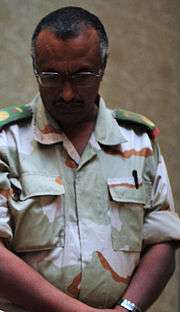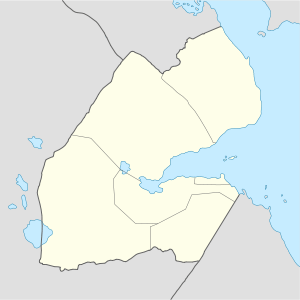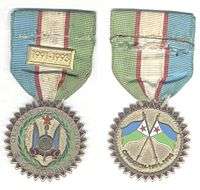Djibouti Armed Forces
| Military of Djibouti | |
|---|---|
|
Emblem of the Djiboutian Armed Force | |
| Motto | Guul ama Dhimasho |
| Founded | 6 June 1977 (39 years) |
| Service branches |
Gendarmerie |
| Leadership | |
| Commander in Chief | President Ismaïl Omar Guelleh |
| Chairman of the Chiefs of Staff | General Zakaria Cheikh Ibrahim |
| Manpower | |
| Military age | 18–49 years old |
| Available for military service | 391,797, age 18–49 (2010 est.) |
| Fit for military service | 268,730, age 18–49 (2010 est.) |
| Reaching military age annually | (2010 est.) |
| Active personnel | 16,000 Active Personnel (2016 est.) |
| Reserve personnel | 9,500 (2016 est.) |
| Deployed personnel |
|
| Expenditures | |
| Budget | $36.90 million (2011 est.) |
| Percent of GDP | 3.7% (2011 est.) |
| Industry | |
| Foreign suppliers |
|
| Related articles | |
| History |
Djiboutian Civil War Djiboutian–Eritrean border conflict United Nations–African Union Mission in Darfur African Union Mission to Somalia |
The Djibouti Armed Forces (DJAF) (Somali: Ciidanka Jabuuti) are the military forces of Djibouti. They consist of the Djibouti National Army and its sub-branches the Djibouti Air Force and Djiboutian Navy. As of 2013, the Djibouti Armed Forces consists of 16,000 (2016 est.) ground troops, which are divided into several regiments and battalions garrisoned in various areas throughout the country. Djibouti Armed Forces are an important player in the Bab-el-Mandeb and Red Sea.
In 2015 General Zakaria Chiek Imbrahim was chief d'etat-major general (chief of staff) of the Forces Armees Djiboutiennes. He assumed command in November 2013.[2]
History
Historically, Somali society accorded prestige to the warrior (waranle) and rewarded military prowess. Except for a man of religion (wadaad), and they were few in number, all Somali males were considered potential warriors. Djibouti's many Sultanates each maintained regular troops. In the early Middle Ages, the conquest of Shewa by the Ifat Sultanate ignited a rivalry for supremacy with the Solomonic Dynasty.

Many similar battles were fought between the succeeding Sultanate of Adal and the Solomonids, with both sides achieving victory and suffering defeat. During the protracted Ethiopian-Adal War (1529–1559), Imam Ahmad ibn Ibrihim al-Ghazi defeated several Ethiopian Emperors and embarked on a conquest referred to as the Futuh Al-Habash ("Conquest of Abyssinia"), which brought three-quarters of Christian Abyssinia under the power of the Muslim Adal Sultanate.[3][4] Al-Ghazi's forces and their Ottoman allies came close to extinguishing the ancient Ethiopian kingdom, but the Abyssinians managed to secure the assistance of Cristóvão da Gama's Portuguese troops and maintain their domain's autonomy. However, both polities in the process exhausted their resources and manpower, which resulted in the contraction of both powers and changed regional dynamics for centuries to come.
The Ogaden War (13 July 1977 – 15 March 1978) was a conflict fought between the Ethiopian government and Somali government. The Djibouti government supported Somalia with military intelligence. In a notable illustration of the nature of Cold War alliances, the Soviet Union switched from supplying aid to Somalia to supporting Ethiopia, which had previously been backed by the United States. This in turn prompted the U.S. to later start supporting Somalia. The war ended when Somali forces retreated back across the border and a truce was declared.
The first war which involved the Djiboutian armed forces, was the Djiboutian Civil War between the Djiboutian government, supported by France, and the Front for the Restoration of Unity and Democracy (FRUD). The war lasted from 1991 to 2001, although most of the hostilities ended when the moderate factions of FRUD signed a peace treaty with the government after suffering an extensive military setback when the government forces captured most of the rebel-held territory. A radical group continued to fight the government, but signed its own peace treaty in 2001. The war ended in a government victory, and FRUD became a political party.

Djibouti has fought in clashes against Eritrea over the Ras Doumeira peninsula, which both countries claim to be under their sovereignty. The first clash occurred in 1996 after a nearly two-months stand-off. In 1999, a political crisis occurred when both sides accused each other for supporting its enemies. In 2008, the countries clashed again when Djibouti refused to return Eritrean deserters and Eritrea responded by firing at the Djiboutian forces. In the following battles, some 44 Djiboutian troops and some estimated 100 Eritreans were killed.
In 2011, Djibouti troops also joined the African Union Mission to Somalia.[5]
As of 2013, the Djibouti Armed Forces (DJAF) are composed of three branches: the Djibouti National Army, which consists of the Coastal Navy, the Djiboutian Air Force (Force Aerienne Djiboutienne, FAD), and the National Gendarmerie (GN). The Army is by far the largest, followed by the Air Force and Navy. The Commander-in-Chief of the DJAF is the President of Djibouti and the Minister of Defence oversees the DJAF on a day-to-day basis.
Component forces and their organization
Djiboutian Army
The Djiboutian Army is the largest branch of the Djibouti Armed Forces. Djibouti maintains a modest military force of approximately 25,500 troops; the army is made of 16,000 troops (IISS 2016). The latter are divided into several regiments and battalions garrisoned in various areas throughout the country.[6] The Army has four military districts (the Tadjourah, Dikhil, Ali-Sabieh and Obock districts).[7] Clashes with the Military of Eritrea, in 2008, demonstrated the superior nature of the Djiboutian forces’ training and skills, but also highlighted the fact that the small military would be unable to counter the larger, if less well-equipped forces of its neighbours. The army has concentrated on mobility in its equipment purchases, suitable for patrol duties and counterattacks but ill-suited for armoured warfare. The 2008 border clashes at least temporarily swelled the ranks of the Djiboutian army, with retired personnel being recalled, but the military’s size and capabilities are much reduced since the 1990s. The army to address more effectively its major defense disadvantage: lack of strategic depth. Thus in the early 2000s it looked outward for a model of army organization that would best advance defensive capabilities by restructuring forces into smaller, more mobile units instead of traditional divisions. The official tasks of the armed forces include strengthening the country against external attack, and maintaining border security. Djiboutian troops continue to monitor its borders with Eritrea, in the case of an attack. The Djiboutian Army is one of the small professional advanced armies in East Africa.

Its maneuver units are:
- One armoured regiment (comprising a reconnaissance squadron, three armoured squadrons and an anti-smuggling squadron)[7]
- Four infantry regiments (each comprising three to four infantry companies and a support company)[7]
- Regiment interarmées de Tadjourah[8]
- Regiment interarmees de Obock
- Two other infantry regiments
- One rapid reaction regiment (comprising four infantry companies and a support company)[7]
- One Republican Guard regiment[7]
- One artillery regiment[7]
- One demining company[7]
- One signals regiment[7]
- One computer and information systems section[7]
- One logistics regiment[7]
- One maintenance company[7]
Italy delivered 10 howitzers M-109L (in 2013), tens IVECO trucks (ACM90, cranes, tankers, etc.), some IVECO armoured car Puma 4X4 and IVECO utility vehicles VM90.
In reforming the Djiboutian Army, most of the available financial resources have been directed to the development of the Land Forces. Over the years, Djiboutian Army has established partnerships with militaries in France, Egypt, Saudi Arabia, Morocco and the United States. Currently, the amount allocated to defense represents the largest single entry in the country’s budget.
Personnel in each service
As of 2016, Djibouti Armed Forces were reported to have 17,360–18,000 active personnel, 9,500–11,400 reserve personnel.
| Component | in service | Reserve |
| 16,000 | 10,000 | |
| 360 | 200 | |
| 1,000 | 1,200 | |
| Totals | 17,360 | 11,400 |
Djiboutian Navy

The Djiboutian Navy is the naval service branch of the Djibouti Armed Forces. The Djiboutian Navy has about 1,000 regular personnel as of 2013, to protect national maritime rights and to support the nation's foreign policies. It is responsible for securing Djibouti's territorial waters and 314 km seaboard. The force was launched two years after Djibouti gained its independence in 1977. Initially, it comprised the remnants of the Gendarmerie and was focused on port safety and traffic monitoring. This is an area known to have considerable fish stocks, sustaining an active fisheries industry. The acquisition of several boats from the US in 2006 considerably increased the navy's ability to patrol over longer distances and to remain at sea for several days at a time. Cooperation with the US and Yemeni navies is also increasing in an effort to protect and maintain the safety and security of the Sea Lanes of Communication (SLOC). In 2004 Italy delivered 2 former Italian Coast Guard Classe 200 patrol boats (ex CP 230 and CP 234 ) and 2 new type CP 500 motorboats.
Djiboutian Air Force
The Djiboutian Air Force (DAF) (French: Force Aérienne du Djibouti (FADD) was established as part of the Djibouti Armed Forces after the country obtained its independence on June 27, 1977. Its first aircraft included three Nord N.2501 Noratlas transport aircraft and an Allouette II helicopter presented to it by the French. In 1982, the Djibouti Air Force was augmented by two Aerospatiale AS.355F Ecureuil 2 helicopters and a Cessna U206G Stationair, this was followed in 1985 by a Cessna 402C Utiliner. In 1985, the Allouette II was withdrawn from use and put on display at Ambouli Air Base at Djibouti's airport. In 1987, the three N.2501 Noratlas were also retired and subsequently returned to France. New equipment came, in 1991, in the form of a Cessna 208 Caravan, followed by Russian types in the early nineties. These included four Mil Mi 2, six Mil Mi 8 and two Mil Mi 17 helicopters and a single Antonov An 28 light transport aircraft. Pilot training for the 360 men of the DAF, if necessary, is conducted in France with continued on type flight training at home. The DAF has no units of its own and forms in whole a part of the Army, its sole base is Ambouli.
Doctrine

The main doctrine consists of the following principles:
- Djibouti cannot afford to lose a war
- A small standing army with good capabilities.
- Desire to avoid war by political means.
Personnel
The size and structure of the Djibouti Armed Forces is continually evolving.
| Republic of Djibouti | ||||||||||
|---|---|---|---|---|---|---|---|---|---|---|
| 1977 | 1979 | 1982 | 1985 | 1989 | 1992 | 1998 | 2000 | 2007 | 2015 | |
| Regular | 2,800 | 4,000 | 6,800 | 8,000 | 9,000 | 20,000 | 13,000 | 12,900 | 10,500 | 16,000 |
| Army Reserve | 1,000 | 1,500 | 2,200 | 4,000 | 500 | 4,500 | 6,000 | 8,000 | 9,500 | |
| Total | 2,800 | 5,000 | 8,200 | 10,200 | 13,000 | 20,500 | 17,500 | 18,900 | 18,500 | 25,500 |
Peacekeeping
Djibouti has committed to strengthening international action through the African Union to achieve collective security and uphold the goals enshrined in the Purposes and Principles of the UN Charter and the Constitutive Act of the African Union. Deployed in 2 countries in Somalia and Sudan. Djibouti’s first contribution to UN peacekeeping was in 2010 in the Darfur, Sudan.
| Country | Mission | Number of personnel |
|---|---|---|
| |
UNAMID | 151 Police Officers |
| |
AMISOM | 2,000 Peacekeeping Troops |
Foreign military within Djibouti
.jpg)
France
France's 5e RIAOM are currently stationed in Djibouti.
United States of America
There is also Combined Joint Task Force - Horn of Africa, a U.S. force of more than 3,500, currently deployed in the country at Camp Lemonnier.[9]
Italy
The Italian Base Militare Nazionale di Supporto (National Support Military Base) is capable to host 300 troops and some UAVs.[10][11][12]
Japan
Deployment Airforce for Counter-Piracy Enforcement (DAPE): Established in 2011 with approximately 600 deployed personnel from the Japan Maritime Self-Defense Force, on a rotational basis, operating naval vessels and maritime patrol aircraft. Japan reportedly pays $30 million per year for the military facilities, from which it conducts anti-piracy operations in the region.. The base also acts as a hub for operations throughout the East African coastline.[13]
References
| Wikimedia Commons has media related to Military of Djibouti. |
- ↑ Ahmed Soliman and David Styan (15 April 2016). "Connecting the Horn of Africa and the Gulf". allafrica. Retrieved 15 April 2016.
- ↑ http://www.hoa.africom.mil/story/7830/djiboutian-armed-forces-top-leader-retires-changes-command
- ↑ Saheed A. Adejumobi, The History of Ethiopia, (Greenwood Press: 2006), p.178
- ↑ Encyclopædia Britannica, inc, Encyclopædia Britannica, Volume 1, (Encyclopædia Britannica: 2005), p.163
- ↑ "Somalia: Djibouti Peacekeepers Arrive in Mogadishu to Join Amisom". Garowe Online. 21 December 2011. Retrieved 22 March 2013.
- ↑ "Présentation des forces armées djiboutiennes". Ministère des Affaires étrangères (France). Retrieved 23 March 2013.
- 1 2 3 4 5 6 7 8 9 10 11 International Institute for Strategic Studies (IISS) (2012). The Military Balance 2012. London: IISS. p. 432. ISSN 0459-7222.
- ↑ http://www.lanationdj.com/fad-regiments-interarmes-de-tadjourah-et-obock-de-jeunes-soldats-recoivent-leurs-premieres-instructions-militaires/
- ↑ "United States military deployments: Information from Answers.com". Answers.com. Retrieved 23 October 2014.
- ↑
- ↑
- ↑
- ↑ Djibouti: Changing Influence in the Horn’s Strategic Hub, chathamhouse.org, David Styan, April 2013 ("Having temporarily used US facilities, a Japanese base, situated close to Camp Lemonnier, opened in July 2011. Around 600 members of its Maritime Self-Defence Forces rotate between Japan’s naval vessels operating from the port of Djibouti and the camp. Naval units protecting Japanese shipping in the region had operated out of the US base prior to 2011. Japan is reported to pay an annual rent of $30 million for the facilities, similar to the sums paid for either of the far larger US and French bases. This has led to an expansion of Japan’s civilian aid programme to Djibouti, which has also become a hub for wider development activities in the Horn by the Japan International Cooperation Agency.")


